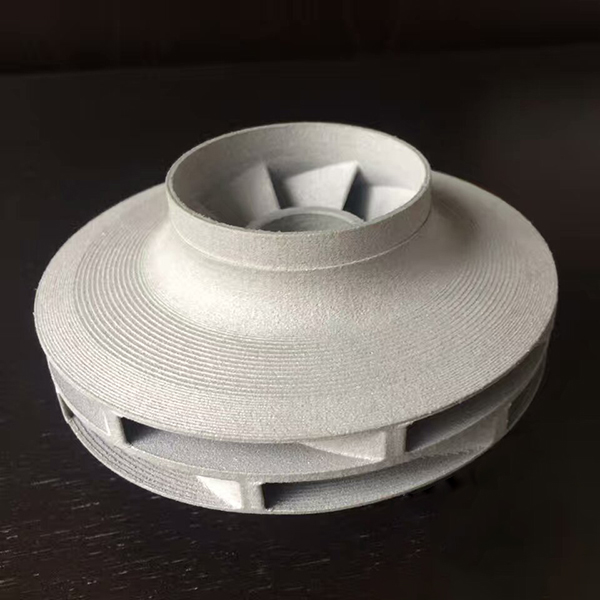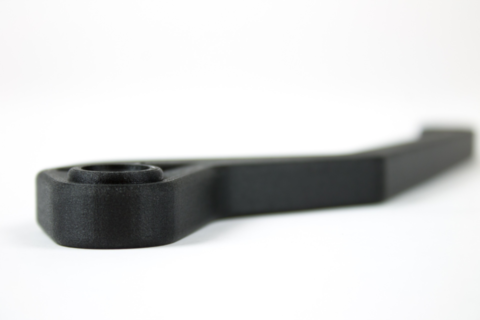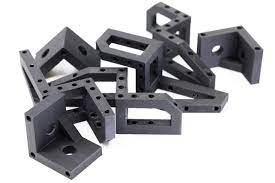Nylon is a broad family of synthetic thermoplastics based on aliphatic or semi-aromatic polyamides. It is often used for SLS 3D printing. Prints made from nylon powder have good surface finishes and great mechanical properties. Nylon or Polyamide (PA) has different variations which characterize the number and nature of chains in a material. This influences the properties of objects fabricated from nylon powder like resistance, stiffness, moisture absorption and flexibility. The common types are Nylon 6, Nylon 6/6 and Nylon 12. Another way of improving the material properties for specific applications is blending polyamide with add-ins to produce composite materials such as:
- Glass-filled Nylon (PA GF) – compared to pure nylon, PA GF demonstrates better stiffness and higher heat resistance but is less flexible and has a natural (off-white) color. The composite is stable, so prints fit better, are machinable, can be used for consumer goods and sports items, and perform well with complex parts.
- Aluminum-filled Nylon (PA AF) – this composite is made by mixing PA with aluminum powder. As a result, objects have a metallic appearance and rigid structure after being printed. PA AF is easy to machine and post-process, less abrasion resistant, more substantial, has a rougher surface, more heat resistant and rigid.
- Carbon Fiber-filled Nylon (PA CF) – another composite with carbon fiber; its main advantage is electrostatically dissipative characteristics. PA CF features include resistant to temperature and wear, sturdy, lightweight, and has anthracite shade.
- Fire-retardant Nylon – despite nylon and its improved versions being heat resistant, this blend can pass the burn test, which makes it an excellent choice for industries requiring fire-retardant parts. Main features include white color, tough, has good mechanical properties, passes smoke and toxicity tests as well.
Below we have shared more details about each Nylon composite material for your reference.
Glass-filled Nylon (PA GF)
PA12-GF, called also PA-GF, is a plastic reinforced with glass. This was designed to get near glass fiber-reinforced plastic.
By the glass filling, this material is very stiff and dimensionally stable and can be used under heavy loads. Like all SLS materials, PA-GF is permanently usable.
Due to the larger diameter of the glass beads in the material-PA GF is less abrasion resistant such as PA12.
It has a much higher thermal resistance (up to 110°C) than polyamide, and is typically used in functional tests with high thermal loads.
Properties
| MEASUREMENT | VALUE |
|---|---|
| Density | 1.22 ±0.03 g/cm³ |
| Tensile Strength | 51 ±3 MPa |
| Tensile Modulus | 3200 ±200 MPa |
| Elongation at Break | 6 ±3% |
| Flexural Modulus | 2900 ±150 MPa |
| Charpy – Impact strength | 35 ±6 kJ/m² |
| Charpy – Notched Impact Strength | 5.4 ±0.6 kJ/m² |
| Izod – Impact Strength | 21.3 ±1.7 kJ/m² |
| Izod – Notched Impact Strength | 4.2 ±0.3 kJ/m² |
| Ball Indentation Hardness | 98 |
| Shore D/A-hardness | D80 ±2 |
| Heat Deflection Temperature | 110°C |
Aluminum-filled Nylon (PA AF)

PA-AF is a blend of aluminum powder and polyamide powder, which allows metallic-looking, non-porous components to be machined easily and is resistant to high temperatures (130°C). Typical applications include parts for wind tunnel testing in the automotive industry, small production runs, jig manufacturing, education and illustrative models with a metallic appearance.
| MEASUREMENT | VALUE |
|---|---|
| Density | 1.36 ±0.05 g/cm³ |
| Tensile Strength | 48 ±3 MPa |
| Tensile Modulus | 3800 ±150 MPa |
| Flexural Modulus | 3600 ±150 MPa |
| Charpy – Impact strength | 29 ±2 kJ/m² |
| Charpy – Notched Impact Strength | 4.6 ±0.3 kJ/m² |
| Shore D/A-hardness | D76 ±2 |
| Heat Deflection Temperature | 130 °C |
| Elongation at Break | 3.5 ±1% |
Carbon Fiber-filled Nylon (PA CF)

FDM Nylon 12 Carbon Fiber (Nylon 12CF) combines nylon 12 and chopped carbon fiber to achieve the highest flexural strength and stiffness-to-weight ratio of any FDM material. Nylon 12CF provides a cleaner carbon fiber additive process than SLA with equivalent strength properties.
It offers the strength and rigidity to replace metal in certain applications. Replace heavy metal tools with lighter, ergonomic carbon fiber FDM tools. Validate designs faster with carbon fiber functional prototypes instead of costly and time-consuming metal prototypes.
| MEASUREMENT | XZ Axis | ZX Axis |
|---|---|---|
| Tensile Strength, Yield | 63 MPa | 29 MPa |
| Tensile Strength, Ultimate | 76 MPa | 34 MPa |
| Tensile Modulus | 7.6 GPa | 2.3 GPa |
| Tensile Elongation at Break | 1.9% | 1.2% |
| Tensile Elongation at Yield | 0.9% | 1.1% |
| Flexural Strength | 142 MPa | 58 MPa |
| Flexural Modulus | 10.3 GPa | 2.07 GPa |
| Flexural Strain at Break | 3% | 3% |
| Compression Strength, Ultimate | 67 MPa | 92 MPa |
| Compression Modulus | 2.7 GPa | 2.2 MPa |
| Heat Deflection (HDT) | 143 °C | 143 °C |
| Glass Transition Temperature (Tg) | 41 °C | 41 °C |
Fire-retardant Nylon

Onyx FR, launched by Markforged, is a flame-resistant variant of Onyx designed for use in applications where parts must be non-flammable. The material earned a UL Blue Card, and is considered V-0 (self-extinguishing) at thicknesses greater than or equal to 3mm. It can be reinforced with any Continuous Fiber and is compatible with industrial composite 3D printers.
| MEASUREMENT | VALUE |
|---|---|
| Tensile Modulus (GPa) | 3.0 |
| Tensile Stress at Yield (MPa) | 41 |
| Tensile Stress at Break (MPa) | 40 |
| Tensile Strain at Break (%) | 18 |
| Flexural Strength (MPa) | 71 |
| Flexural Modulus (GPa) | 3.6 |
| Heat Deflection Temp (oC) | 145 |
| Flame Resistance | V-0 |
| Density (g/cm3) | 1.2 |
Composite Nylon Materials Offered by FacFox
| Materials | SLS Nylon PA 12 Glassfilled (PA12 Glassfilled) |
FDM Nylon 12CF (FDM Nylon 12 Carbon Fiber) |
MJF Nylon PA 12 GlassBeads (HP 3D High Reusability PA 12 Glass Beads) |
|---|---|---|---|
| Technology | SLS | FDM | MJF |
| Price | $$ | $$$ | $$$ |
| Max Size | 700 x 380 x 580 mm | 900 x 610 x 900 mm | 380 x 284 x 380 mm |
| Min Size | 3 x 3 x 3 mm | 10 x 10 x 10 mm | 5 x 5 x 5 mm |
| Default Layer Height | 0.1 mm | 0.254 mm | 0.08 mm |
| Optional Layer Heights | 0.1 mm | 0.127, 0.254 mm | 0.08 mm |
| Tolerance | ±0.3% | ±0.2% | ±0.2% |
| Heat endurance | N/A | Under 143 ℃ | Under 121 ℃ |